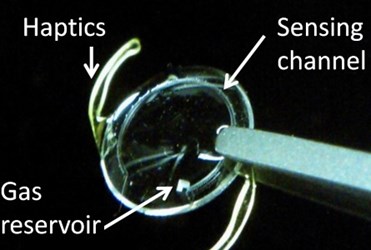Implantable Glaucoma Sensor For On-Demand Pressure Measurement
By Chuck Seegert, Ph.D.

One of the leading causes of blindness in people across the globe is glaucoma. This disease is caused by increased intra-ocular pressure (IOP) that eventually degrades retinal cells and causes enough optic nerve damage that blindness ensues. There are a number of treatments, along with ways to measure and understand the status of the disease’s advance. Generally, however, these all require specialized equipment, which results in weekly visits to the doctor’s office.
IOP is not always a reliable measurement, as it can vary with a number of factors similar to blood pressure. A single weekly measurement may not be enough to accurately gauge the progress of the disease. Now, with the help of a small eye implant, it may be possible to measure pressure and transmit data from the comfort of a patient’s home — an advance that may help up to 2.2 million Americans, according to a recent article from Stanford University.
The device consists of a small tube that has been incorporated into a lens implant. One end of the tube is open to the fluids in the eye and the other is closed off with a small portion of gas inside the tube. As the pressure in the eye increases, the fluid is pushed further into the tube. Using a smart phone, the meniscus of the fluid can be read in relation to a scale that is closely associated with the tube. According to a research study published by the team in Nature Medicine, the accuracy of the sensor is very high and allows detection of pressures as low as 1 mm Hg.
The potential value of this device is illustrated by the fact that patients monitored on a 24-hour basis have changes to their treatment regimen up to 80 percent of the time. These changes increase the effectiveness of their treatment and how they respond to the disease.
"For me, the charm of this is the simplicity of the device," said Stephen Quake, a professor of bioengineering and of applied physics at Stanford, in the Stanford article. "Glaucoma is a substantial issue in human health. It's critical to catch things before they go off the rails, because once you go off, you can go blind. If patients could monitor themselves frequently, you might see an improvement in treatments."
Currently, the device is incorporated into a lens implant that is received by only a small percent of the glaucoma population, according to the article. However, the design could be changed to allow the device to be implanted in any glaucoma patient in need of constant monitoring.
Monitoring of IOP is an important and burgeoning area of research. Recently, a microelectronic implant was also used to study IOP.
